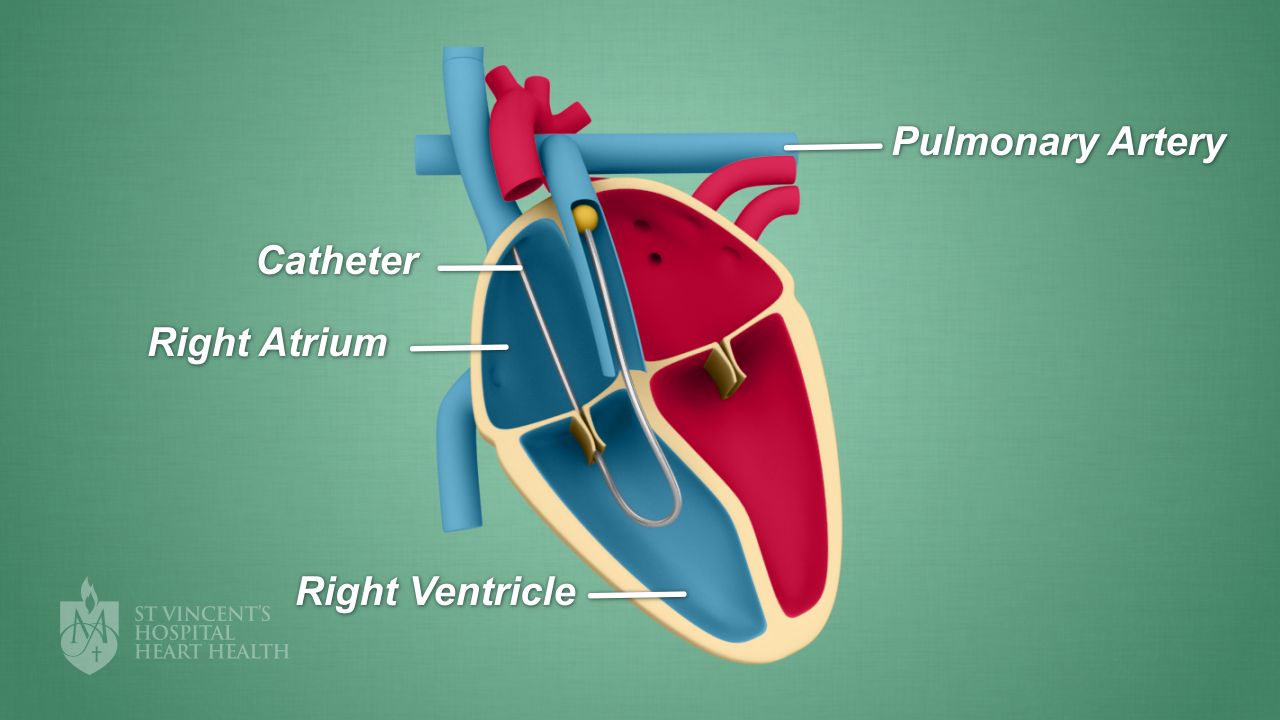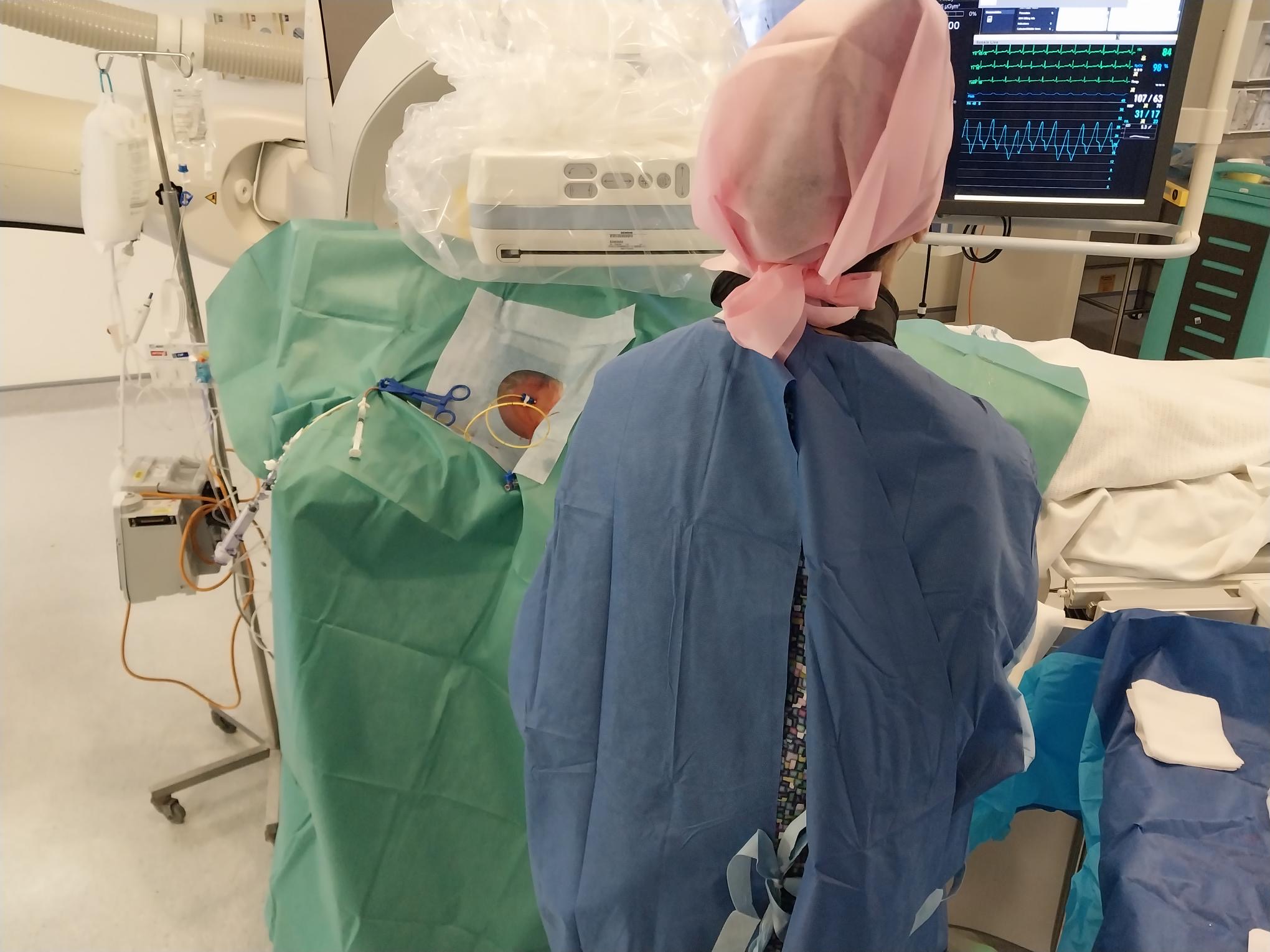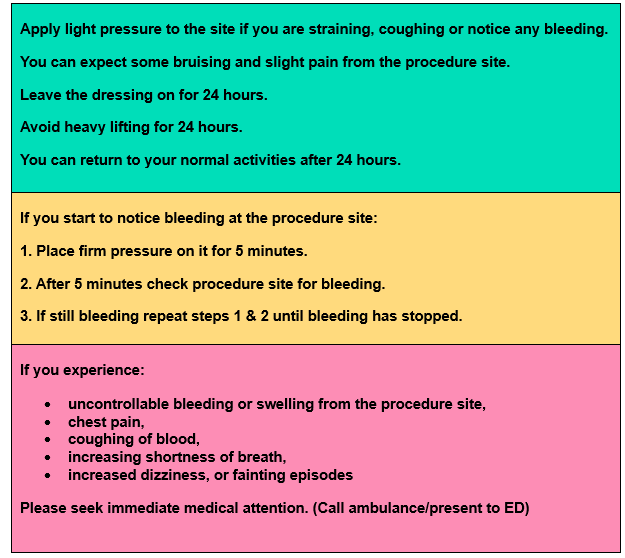Right Heart Catheter
In a right heart catheter procedure, a catheter is passed into a vein in your neck or groin to measure the pressure in your heart and lungs.
What is a right heart catheter?
Why do I need a right heart catheter?
How do I prepare for a right heart catheter?
What happens during a right heart catheter?
What are the risks of having a right heart catheter?
What happens after a right heart catheter?
What is a right heart catheter?
A right heart catheter is a specially designed tube to allow us to measure pressures in the right side of your heart. To reach the heart the tube is placed into a vein in your neck, groin or arm.
The procedure helps your doctor understand how well your heart and lungs are working and guide your treatment.
This image below shows a right heart catheter.

Why do I need a right heart catheter?
A right heart catheter is used to diagnose, manage and examine patients for conditions such as:
If you have recently had heart transplant surgery, your doctor may also perform a heart biopsy during a right heart catheter. A heart biopsy checks if there is any inflammation in your heart, or if your body is not accepting the donor heart.
How do I prepare for a right heart catheter?
Day before the procedure
- We will call you to tell you what time your procedure is and when you need to stop taking your blood thinners.
- You can ask us any questions.
- Please contact the Interventional Cardiology Services on (02) 8382 3484 with any queries or concerns.
Morning of the procedure
- Fasting can cause dehydration and effect the results of the right heart catheter.
- You can eat and drink as normal. (No need to fast)
- You can take your usual medications this includes ones for diabetes. If you are taking blood thinners follow the instructions from your doctor.
When you come to hospital
You will be checked in at the:
- Day Procedure Centre (DPC) on Level 5 of the Xavier building (if you are a public patient) or
- Day of Surgery Admissions (DOSA) in the Private Hospital on Level 6 (if you are a private patient).
- We will give you a hospital gown to change into.
- You will need to take off any jewellery around your neck.
- Please tell us if you are claustrophobic or feeling anxious, we can give you some medication to help calm you down.
What happens during a right heart catheter?
- We will take you to the procedure room on a trolley or wheelchair.
- We will ask you to lie flat on a narrow table - let us know if you experience any back or breathing problems.
- You will be awake throughout the procedure, unless we give you a sedative.
- Let us know if you would like us to play music during the procedure to help keep you relax.
- The procedure usually takes 30 to 60 minutes.
During your procedure, your doctors and nurses will:
- Connect you to a heart, oxygen and blood pressure monitor
- Clean your skin over the neck, groin or arm
- Cover the cleaned area with a drape. (your face will be covered if we are going to use your neck vein)
- Give you local anaesthetic to numb the area
- Gently pass a catheter into a vein to the heart
- Record pressure readings from the heart chambers and lungs
- Take blood
- Give you medication, depending on your heart’s pressure readings
- Remove the catheter and apply pressure and a dressing to where it was inserted
Below is an image of a right heart catheter being performed via the neck.

During the procedure, you:
- Will hear some mechanical noises as we use ultrasound and x-rays to make sure the catheter is placed safely in the correct position.
- Will feel some very brief stinging and slight pain when the local anaesthetic is administered.
- You should only feel pressure, not pain after the local anaesthetic has taken effect. Make sure to tell us if you are feeling pain or discomfort.
- May feel some palpitations when the catheter is being inserted.
What are the risks?
As with any procedure, there are some risks associated with a right heart catheter. Your doctor will explain the risks to you before you agree to the procedure. You can ask any questions or tell us your concerns.
Once you are informed about the procedure and risks your doctor will also ask you to sign a consent form to agree to the procedure.
There is a low risk of complications but to ensure you are well informed we have included them here. These include:
Common:
- Arrhythmias - the catheter can irritate the heart and cause an abnormal heart rhythm, usually transient
- Minor bleeding – bleeding can occur around the insertion site, usually resolves from pressure to the area
- Bruising – around the insertion site can occur, usually will self resolve
Rare:
- Bleeding - can occur around the heart when the catheter is inserted
- Infection – germs could be introduced to the blood stream or heart when the procedure is being performed
- Pneumothorax - during insertion of the catheter the lung can accidentally be punctured causing it to collapse
- Thrombosis - blood clots can form around the catheter and travel to the lung
- Injury of vein or artery - damage of the blood vessels can occur when attempting to insert the catheter
- Heart injury - the catheter could injure the structures of the heart e.g. heart muscle, (if this occurs you may require urgent intervention in the operating theatre)
- Wire or catheter displacement - the wire used to place the catheter, or the catheter itself could be misplaced and/or damaged
- Air embolus - air could be introduced into the blood vessel
- Death - extremely rare but there is a risk of death with any procedure
What happens after a right heart catheter?
When the procedure is done, we will monitor you in the recovery unit. Your doctor will briefly explain the results and organise an appointment to formally discuss the results.
- Most patients will go home the day of the procedure.
- We will offer you something to eat and drink.
What do I do after a right heart catheter?
